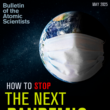In his article “Deterrence, without nuclear winter,” Seth Baum argues that the greatest danger associated with current nuclear stockpiles is that nuclear winter will inevitably follow a nuclear strike and “threaten the whole of humanity.” To avoid such a catastrophic outcome, and thus promote drastic reductions in nuclear weapons, Baum proposes that nuclear states consider alternative weapons that would at once meet their deterrence objectives and preserve humanity from the devastating effects of a nuclear winter. Baum identifies five qualities that such ideal alternative weapons should possess: They should be “politically acceptable,” “not pose a significant proliferation risk,” not “destabilize the international system,” and possess a deterrent value while being “affordable and technologically feasible.” Baum concludes that “non-contagious biological weapons” possess such qualities and would constitute a “good” alternative to nuclear weapons.
I suspect that most nonproliferation analysts—particularly bioweapons experts— have found this proposition to be shortsighted. Baum’s suggestion simply redounds to advocating the violation of the Biological Weapons Convention (BWC)—a nonproliferation treaty that bans the development, production, and stockpiling of biological weapons. The article also ignores historical realities that are important to highlight because they demonstrate that biological weapons possess none of the attributes that Baum lists as essential for an alternative to nuclear weapons.
Among the nine nuclear weapons states—the United States, the United Kingdom, Russia, France, China, India, Pakistan, North Korea, and Israel—all but one (Israel, which has not openly declared its nuclear state status) have signed the BWC. Under the treaty, states agreed to destroy their bioweapons arsenals and refrain from developing, producing, and stockpiling bioweapons. Therefore Baum’s suggestions to promote nuclear disarmament by nudging nuclear states toward bioweapons development is akin to erasing over 40 years of international negotiations and achievements, the greatest of which was the development of an international norm against the development and use of biological weapons. In addition, if powerful states such as Russia and the United States were to resume their past bioweapons programs, they would not only place other nations at a disadvantage due to their lack of accumulated expertise in the field, but this would also have a chilling effect on all types of nonproliferation efforts, including nuclear disarmament. Why would North Korea renounce nuclear weapons when they could use them to counter the nuclear or bioweapons threat from more powerful states? Baum’s proposal is neither politically acceptable nor strategically advisable, while it also carries significant proliferation risks.
In his article, Baum puts the emphasis on “non-contagious biological weapons,” presumably because if these weapons cause non-contagious diseases, their effects would be more limited, making them somehow more acceptable. But the BWC makes no distinction between contagious and non-contagious bioweapons. All bioweapons are banned under the treaty. None is more acceptable than the other. Besides, historically most state and non-state bioweapons programs have focused on agents that do not cause contagious diseases, such as Bacillus anthracis (anthrax) and botulinum toxin. Very few programs have actually worked on contagious agents such as the smallpox virus. Non-contagious does not mean less lethal.
Further, biological weapons are poor deterrents. In addition to the fact that states can protect their populations beforehand, and in some cases even after an attack, depending on the agent used and the length of the incubation period, biological weapons do not guarantee a certain level of predictable destruction as nuclear weapons do. They are sensitive to light and weather conditions, making their use less effective during the day, when ultraviolet light can destroy the agents, or in windy conditions, when agents can inadvertently disseminate over unintended populations. Changes in air currents within cities and over variable terrain make it difficult to achieve accurate targeting. Their effects can also be mitigated by individual immune responses. Because of their sensitivity to environmental conditions, biological weapons are also difficult to deploy, making their use for a second strike problematic.
Historically, because of their unpredictability and the uncertainty of their outcomes, biological weapons were never fully integrated in US military doctrine. In the Soviet Union, the military also viewed bioweapons as unreliable, due to the difficulty of controlling their dispersion and the possible risks of infecting Soviet troops. Attempts by Soviet scientists to develop new biological agents, unknown in nature, which the enemy could not protect against, lasted about 20 years and did not go beyond the exploratory and research and development phases. Furthermore, both the United States and Soviet Union struggled to design effective missile systems for the delivery of these weapons. The US program did not produce a dedicated bioweapons cruise missile, and the Soviets could not solve technical difficulties associated with the development of a ballistic missile warhead that could effectively protect fragile bioagents against the stress of re-entry.
These challenges underscore my final point: Bioweapons are technically complex and can be very expensive. Their complexity derives from their reliance on living microorganisms that are highly sensitive to their environmental and handling conditions. Their behavior throughout the development process is unpredictable, which—as past state and terrorist programs show—causes many failures and delays in program advancement. Furthermore, the stages of a bioweapons lifecycle—research, development, production, scale-up, weaponization, and testing—are highly interdependent, and the successful passage from one stage to the next requires organizational and managerial conditions that promote coordination, cooperation, and information exchange among the various teams of experts involved. Such conditions are particularly difficult to achieve. As a result, most past state and non-state bioweapons programs have been unsuccessful at reaching their goals. The Soviet Union, which had the longest-running and largest program, spent an estimated $35 billion over the last 20 years of the program’s life but was unable to develop the new agents that it aimed to produce. The US program cost about $700 million over 27 years without producing a weapon that satisfied military requirements. Iraq spent over $80 million during the last five years of its program but was only able to produce ineffective weapons that would have destroyed most of the agents they contained upon impact. Finally, South Africa and the Japanese terrorist group Aum Shinrikyo spent about $30 million and $10 million respectively, but failed at all stages in a futile quest for bioweapons. Thus, bioweapons are hardly affordable, and their technical feasibility is constrained by a host of factors, of which I have mentioned only a few.
In short, bioweapons are not an alternative to nuclear weapons. Proposing to sacrifice the biological nonproliferation regime to ensure nuclear disarmament is simply shortsighted.
Share: [addthis tool="addthis_inline_share_toolbox"]














